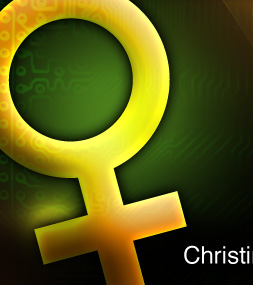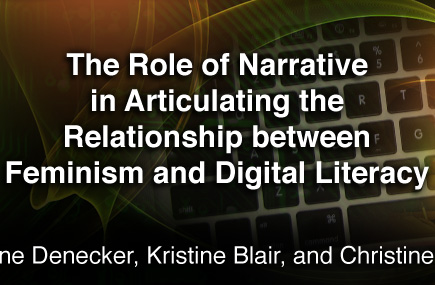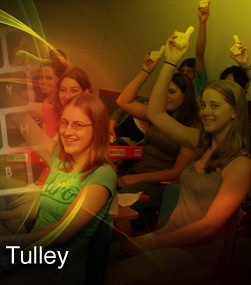Kris Blair: Feminist (Re)Positioning: From the Global to the Local and Back Again
In the collaborative introduction to Computers and the Teaching of Writing in American Higher Education: 1979-1996: A History (1996), Hawisher, LeBlanc, Moran, and Selfe contend that
As historians, we have worked against the limits of our situation, incorporating others’ voices and perspectives in interviews at the end of each chapter, in sidebar text, and in the MOO that concludes the book. We are still, however, only four, and the voices added to our history are not all possible voices, but our own selection of available materials. (p. 3).
With interviews of teacher-scholars such as Myron Tuman, Hugh Burns, and Patricia Sullivan, this chronicle of the sub-discipline of computers and writing was, as Lisa Gerrard concluded in her preface to the history, “less concerned with tracing every historical moment…than with tracing the development of a particular community” (p. xi). Although it was not the first text to emphasize the metaphor of community in the formation of the field (see Carolyn Handa’s collection Computers and Community, 1990), the book became the touchstone for other histories of the discipline, including James Inman’s Computers and Writing: The Cyborg Era. Published eight years later, Inman’s history featured a series of sections titled, “Community Voices,” in which both newer and more established members of the field responded to a series of questions about how they became members of the community, what projects influenced them most, the lessons they learned, and, perhaps most importantly, what worried them about the community. Although Inman’s emphasis on the political and pedagogical potential of cyborg theory (Haraway, 1985) has its roots in feminist dialogues about empowerment and transformation in digital spaces, the overall emphasis in both histories on inclusiveness and multivocality in shaping knowledge about the field is inherently feminist in both theory and practice.
As someone who was asked to respond to Inman’s question about what project influenced them most, I could not help discussing my collaboration with Pamela Takayoshi on the edited collection, Feminist Cyberscapes (1999), a collaboration that allowed us to make long-long lasting connections with mentors and colleagues in the field. Over the years, those connections evolved into a sustainable feminist community whose collective voice has interrogated both dominant cultural narratives characterizing technology as a male domain and emerging disciplinary narratives that positioned electronic writing spaces as uniformly empowering for all students regardless of their gender, race, class, age, or sexual orientation. In so doing, that critical, cultural work has complicated the larger narratives of both disciplinary community and virtual community (as popularized by Rheingold in his 1993 book The Virtual Community) by allowing for more localized, individual, personal accounts of literate practice, including our own voices and some of those voices chronicled within the Digital Archive of Literacy Narratives (DALN).
Localized Histories
"Artifacts" Video File
(transcript)
Just as writing and communication technologies evolve, so too do our methods of documenting larger disciplinary histories and our personal roles within them. In 2008, I participated in a DALN advisory board meeting in Columbus, Ohio. Along with colleagues such as Gail Hawisher and Cynthia Selfe, I spent a long Saturday in May user-testing the web-based interface designed to host literacy narratives from individuals and groups of diverse abilities, generations, cultures, and ethnicities. The testing process also involved participants interviewing each other, and I was honored to interview Gail Hawisher and to have her interview me. Our task appeared simple: to discuss the range of literacies that our families, our schooling, and our personal journeys had fostered. Yet the narratives that evolved from both interviews became a shared story of two feminist teacher-scholars developing technological literacies in the 80s and early 90s when technology in general and technofeminist-based approaches in particular were in their nascent stages within rhetoric and composition studies.
I focus on these literacy narratives because, for me, this interview process illuminates my growth as a “technofeminist," a role that Judy Wajcman (2003) has characterized as an “engagement with the process of technical change [that] must be a part of the renegotiation of gendered power relations” (p. 8). Part of that renegotiation involves recognition that the point of entry into technological literacy for women is often a gendered process.
My dialogue with Gail included a chronicle of my emphasis on the representation of women in online spaces and the extent to which women could tap into technology for their professional goals and personal needs, something Gail and I both implicitly address in our histories as we discuss our first introductions to computers in the early 1980s and how our paths converged during a research project (Hawisher and Sullivan, 1998) Gail conducted with the group WomenatWaytoofast. This project, along with Feminist Cyberscapes, provided occasions during which I became part of a computers and writing community.
As researchers, both Gail Hawisher and Cindy Selfe have served as profound role models and mentors to me as a graduate student, then, and as a faculty member now. Their modeling, I would argue, is clear from Gail’s continued generosity to me in the interview itself, and from her efforts to involve me as a participant in projects that included the DALN project in which we are all currently engaged. The DALN offers us the opportunity not only to collect the diverse stories of colleagues, family, friends, neighbors, and community members but also to understand, as Gail and Cindy astutely conclude, that we should feature these “stories because they resonate with our own stories…the ways in which they have learned to use and cope with technology” (p. 646). For computers and writing specialists, and for feminists, narrative has helped us to theorize more localized relationships to technology that are not always utopic, not always positive, but always mediated through cultural context and the specific material conditions that enable and constrain access for individuals. As a result, those relationships are always complicated, not just for students, but for ourselves as feminist teacher-scholars and for the discipline at large, as we all navigate larger global and cultural narratives of technological progress using our own local perspectives. These local perspectives align theory with practice and the rhetorics of technology with the realities of technology use in the lives of women and other cultural groups.


